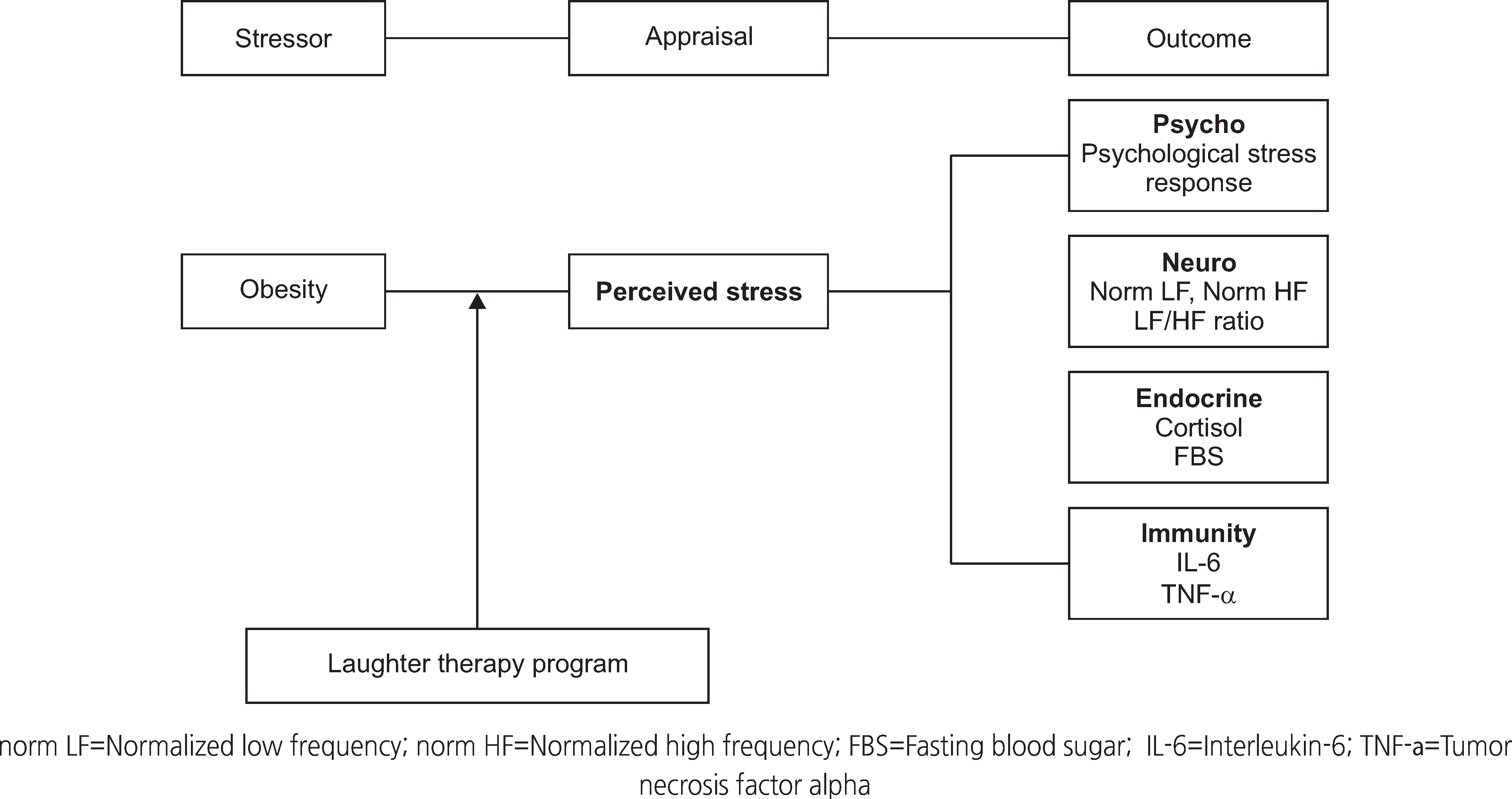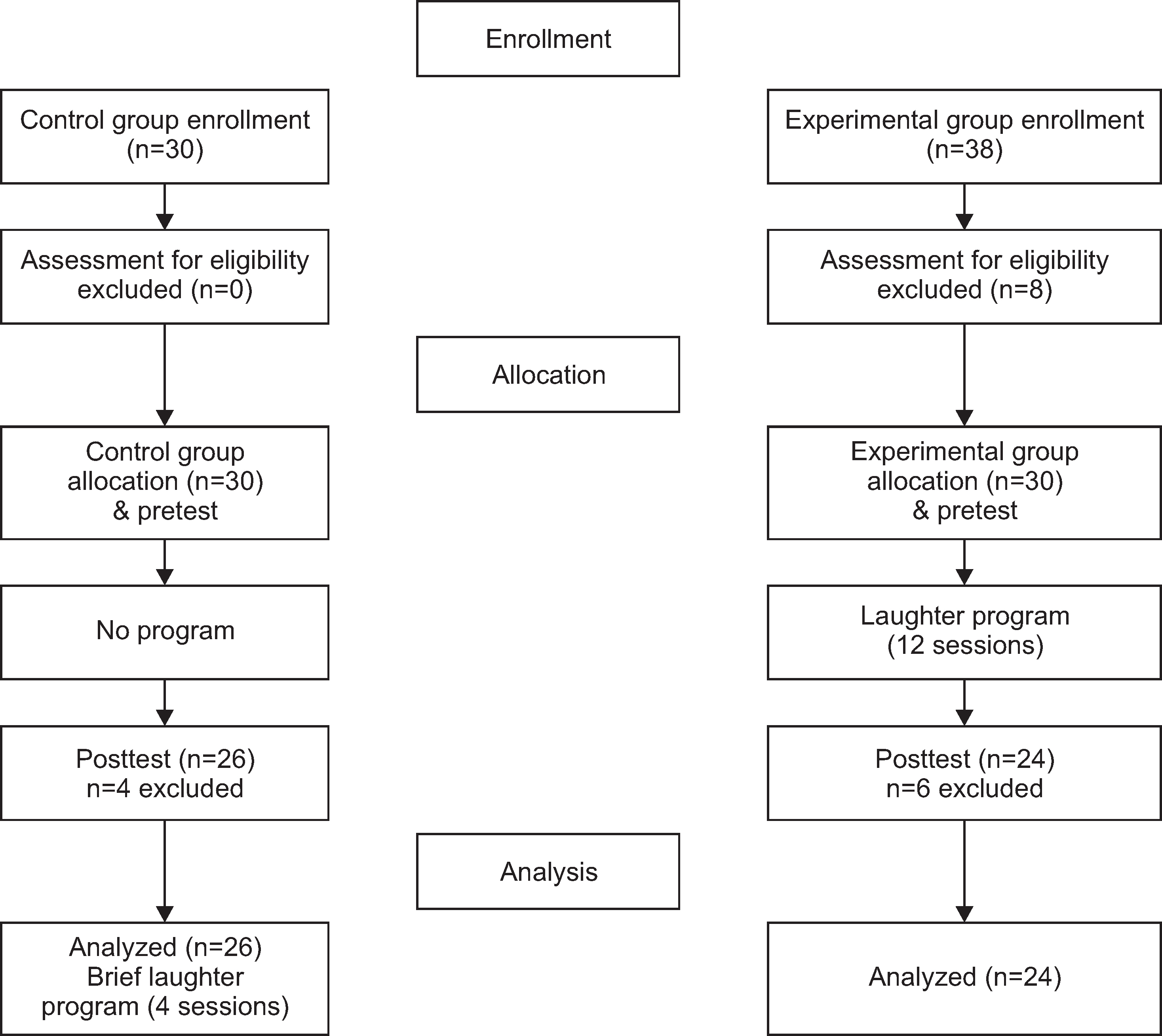J Korean Acad Nurs.
2018 Jun;48(3):298-310. 10.4040/jkan.2018.48.3.298.
The Effects of Laughter Therapy Program on Perceived Stress, and Psycho-Neuro-Endocrino-Immuno Responses in Obese Women
- Affiliations
-
- 1Department of Nursing, Changshin University, Changwon, Korea.
- 2College of Nursing · Institute of Nursing Science, Ajou University, Suwon, Korea. mhyun@ajou.ac.kr
- KMID: 2429106
- DOI: http://doi.org/10.4040/jkan.2018.48.3.298
Abstract
- PURPOSE
The purpose of this study was to examine the effects of the laughter therapy program on perceived stress and psycho-neuro-endocrine-immune responses in obese women.
METHODS
A nonequivalent control group with a pretest-posttest design was used. The participants (n=60), whose age ranged from 30 to 50 years (pre-menopausal and body mass index of over 25 kg/m2), were assigned to the experimental group (n=24) or control group (n=26). The experimental group was provided with the laughter therapy program (12 sessions) for 6 weeks.
RESULTS
There were significant differences in perceived stress, psychological stress response, fasting blood sugar, interleukin-6, and tumor necrosis factor alpha between the two groups after the program. However, there were no significant differences in normalized low frequency (norm LF), normalized high frequency (norm HF), LF/HF ratio, and cortisol between the two groups after the program.
CONCLUSION
It was found that the laughter therapy program had positive effects on some variables in terms of perceived stress and psycho-neuro-endocrine-immuno responses. It is suggested that the laughter therapy in this study can provide the direction for developing a program for obese women.
MeSH Terms
Figure
Reference
-
References
1. WHO. Health topic: Obesity [Internet]. Geneva: World Health Organization;c2015. [cited 2018 Jan 25]. Available from:. http://www.who.int/topics/obesity/en/.2. Statistics Korea. Korea National Health and Nutrition Survey: Obesity prevalence rate [Internet]. Daejeon: Ministry of Health & Welfare;c2016. [cited 2018 Jan 25]. Available from:. http://www.index.go.kr/potal/main/EachDtlPageDetail.do?idx_cd=2705.3. Ministry of Health & Welfare. National Health Insurance Service. 2016. National Health Statistics [Internet]. Daejeon: Ministry of Health & Welfare;c2017 [cited 2018 Jan 25]. Available from:. http://www.mohw.go.kr/react/al/sal0301vw.jsp?PAR_MENU_ID=04&MENU_ID=0403&CONT_SEQ=342900&page=1.4. Brewis AA. Stigma and the perpetuation of obesity. Social Science & Medicine. 2014; 118:152–158. https://doi.org/10.1016/j.socscimed.2014.08.003.
Article5. Scott KM, McGee MA, Wells JE, Oakley Browne MA. Obesity and mental disorders in the adult general population. Journal of Psychosomatic Research. 2008; 64(1):97–105. https://doi.org/10.1016/j.jpsychores.2007.09.006.
Article6. Nam SJ, Park JH. Depression and stress related to obesity among normal, obese, and severe obese groups-Comparison among normal, obesity, and severe obesity groups. Korean Journal of Human Ecology. 2012; 21(6):1199–1210. https://doi.org/10.5934/KJHE.2012.21.6.1199.7. Kim KJ, Hong HS, Park WJ, Ko SJ, Na YK. Effects of an abdominal obesity management program on physiological bio-markers of middle-aged women in Korea: A meta-analysis. The Korean Journal of Obesity. 2016; 25(3):138–149. https://doi.org/10.7570/kjo.2016.25.3.138.
Article8. Sok DE. Psychoneuroendocrinoimmunology. Bio-psycho-socio-spiritual approach. Daejeon: Chungnam National University Publishing Center;2012. p. 17–20.9. Kim DH. An overview of psychoneuroimmunology. Korean Journal of Biological Psychiatry. 2008; 15(3):147–151.10. Kim YM, Ahn SH. A review of postpartum depression: Focused on psychoneuroimmunological interaction. Korean Journal Women Health Nursing. 2015; 21(2):106–114. https://doi.org/10.4069/kjwhn.2015.21.2.106.
Article11. Park SE, Kim JH, Jeung GW, Kim KS. Assesment of heart rate variability by integral pulse frequency modulation model. The Transactions of the Korean Institute of Electrical Engineers. 2015; 64(5):799–804. https://doi.org/10.5370/KIEE.2015.64.5.799.
Article12. Kim BS, Min JA. Application and interpretation of HRV in stress clinic. Seoul: Pan-Mun Education;2015. p. 1–140.13. Kern PA, Gregorio GB, Lu T, Rassouli N, Ranganathan G. Relation to obesity, insulin resistance, and tumor necrosis factor-α expression. Diabetes. 2003; 52(7):1779–1785. https://doi.org/10.2337/diabetes.52.7.1779.14. Lazarus RS, Folkman S. Stress, appraisal and coping. New York: Springer Publishing Company;1984. p. 11–52.15. Welliver M. Laughter: The best medicine or best measure? Gastroenterology Nursing. 2012; 35(2):135–136. https://doi.org/10.1097/SGA.0b013e31824ed403.16. Ripoll RM, Casado IQ. Laughter and positive therapies: Modern approach and practical use in medicine. Revista de Psiquiatría y Salud Mental (English Edition). 2010; 3(1):27–34. https://doi.org/10.1016/S2173-5050(10)70006-6.
Article17. Choi JH, Kim KH, Cha SJ, Pyo HJ, Kim YK. Effects of laughter therapy on mood, pain, and stress of mastectomy patients. Journal of Korean Clinical Nursing Research. 2010; 16(1):83–93.18. Han HJ, Park A, Kim HS, Moon HK, Park YH. The effects of laughter therapy on stress responses in patients with preoper- ative breast cancer. Journal of Korean Oncology Nursing. 2011; 11(2):93–100. https://doi.org/10.5388/jkon.2011.11.2.93.19. Oh EY, Kang KH, Son OL, Wo MA, Lee MS, Kim SJ. The effects of laughter therapy on stress response and coping for specialized burn hospital nurses. Korean Journal Stress Research. 2011; 19(4):323–331.20. Cha MY, Hong HS. Effects on the laughter score, cortisol and immunoglobulin of laughter therapy in middle aged women. Journal of Korean Biological Nursing Science. 2013; 15(4):230–236. https://doi.org/10.7586/jkbns.2013.15.4.230.
Article21. Lee DY, Seo HY, Lee BC, Jung GH. Development and effects of laughter therapy program in geriatric successful aging and stress in elderly. Journal of the Korea Convergence Society. 2016; 7(4):199–208. https://doi.org/10.15207/JKCS.2016.7.4.199.
Article22. Kang JS. A meta-analysis of laughter therapy in Korean journal. Asia-Pacific Journal of Multimedia Services Convergent with Art, Humanities, and Sociology. 2017; 7(1):489–501. https://doi.org/10.14257/AJMAHS.2017.01.08.
Article23. Cohen S, Kamarck T, Mermalstein R. A global measure of perceived stress. Journal of Health and Social Behaviour. 1983; 24(4):385–396.
Article24. Ha YS, Jeong GH, Kim SJ. Relationships between perceived stress during the maternal role attainment process and health-promoting lifestyle practice. Nursing Science. 1990; 2:23–47.25. Koh KB, Park JK, Kim CH. Development of the stress response inventory. Journal of the Korean Neuropsychiatric Association. 2000; 39(4):707–719.26. Foley E, Matheis R, Schaefer C. Effect to forced laughter on mood. Psychological Reports. 2002; 90(1):184.27. Lynn MR. Determination and quantification of content validity. Nursing Research. 1986; 35(6):382–385.
Article28. Min KS. Analysis of the stress between mother and fetus and development of algorithm for labor prediction using heart rate variability [dissertation]. Daejeon: Chungnam National University;2006. p. 1–51.29. Woo JM. The concept and clinical application for the measurement of heart rate variability. Korean Journal of Psychosomatic Medicine. 2004; 12(1):3–14.30. Matsuzaki T, Nakajima A, Ishigami S, Tanno M, Yoshino S. Mirthful laughter differentially affects serum pro- and anti-inflammatory cytokine levels depending on the level of disease activity in patients with rheumatoid arthritis. Rheumatology (Oxford). 2006; 45(2):182–186. https://doi.org/10.1093/rheumatology/kei081.
Article
- Full Text Links
- Actions
-
Cited
- CITED
-
- Close
- Share
- Similar articles
-
- Effects of Laughter Therapy on Postpartum Fatigue and Stress Responses of Postpartum Women
- An Effect of Optimism, Self-esteem and Depression on Laughter Therapy of Menopausal Women
- The Effects of Laughter Therapy for the Relief of Employment-Stress in Korean Student Nurses by Assessing Psychological Stress Salivary Cortisol and Subjective Happiness
- Effects of Visiting Laughter Therapy on Depression and Insomnia among the Vulnerable Elderly
- The Effect of Laughter Therapy on Arthralgia, Ankylosis, Depression, and Sleep of Elderly Housebound Women with Osteoarthritis



